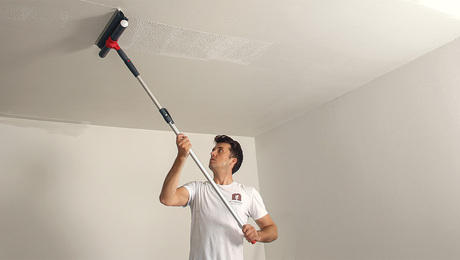Comfortable Dining Nooks
Once you settle on the location, focus on providing maximum comfort to the users
Location is first
Corner seat at 45°
Corners often make good sites for nooks, but square corners create dead spots that are not useful for seating. If there is enough space, it is usually better to cross the corner with a seat at 45° to the two sides. It usually works best with a round or oval table, and it requires a relatively wide space for the nook.
Just like designing a house, designing a good nook starts with the site. Proximity to the food-prep area is important, but the primary concerns are traffic patterns and light. Locate the nook out of the way of major thoroughfares, if possible. The seating should be easy to get in and out of. Restaurant-style booths don’t work well without waitstaff. “Captive” seats should have more than one way out, not including crawling under the table. This generally limits built-in seating to two sides of a rectangular table or 180° of a round table.
The sun is always the best source of light. If possible, locate the nook near windows, and incorporate those windows into the design of the nook. (Be sure to use tempered glass if the windows are within reach of elbows.) East- or south-facing windows are best for daylight. Also, consider any existing or potential views to the outside. If there is nothing worth seeing outside, consider interior views of adjacent rooms and architectural features.
Artificial lighting should be planned not just for dining, but also for table activities such as work, games, and crafts. Provide ambient as well as direct overhead light, making sure to locate fixtures to avoid glare at seated eye level. Dimmers on all fixtures will allow light to be adjusted for a wide range of activities.
Comfort comes next
Once the big questions of location, layout, and lighting are settled, it’s time to move to the ergonomics of the seat itself. There is no need to reinvent the seat. You might start with a bit of empirical research, trying out restaurant booths until you find a comfortable one, then measuring it. If you don’t find one quickly, this method could get expensive, though enjoyable as long as the food is better than the seating.
There is a lot of anthropometric data out there. Because a lot of industries depend on it, I was surprised to find that not much solid information is available online. The American Institute of Architects’ Architectural Graphic Standards, 11th ed. (Wiley & Sons, 2007), probably has enough to get you started on a comfortable design, but the best source I know of is Humanscale 1/2/3 (MIT Press, 1974). This portfolio contains a booklet with anthropometric measurements, a comprehensive list of seating-design considerations, a discussion of design requirements for the handicapped and elderly, and three pictorial selectors containing rotary dials that give specific dimensions for designing for people of various sizes. Unfortunately, it is now out of print. The drawing below shows how I applied Humanscale dimensions to a particular project.
If you plan to use seat cushions, 1-in. to 2-in. of firm padding is plenty. Don’t lower the seat by much, because the foam will compress. Lumbar support is an important feature for long-term seating comfort, but I usually ignore it for built-ins. Properly curved lumbar support would require bending plywood or horizontal slats (coopered or butted) for the back rest. Throw pillows are simpler and more cost-effective.
After arriving at a design in cross section, make a mock-up about 24-in. wide. (I did this for the seat shown in “A Built-In Corner Seating Nook” from FHB#225.) I had started with a seat pitch of 5°. However, test sitters found the seat more comfortable when angled back about 5° more, so I adjusted the angle.
Once you have a comfortable seat, consider storage. The table usually will make access to any space under the seat a bit awkward, so it’s better to make the access from the ends. If that does not work for your layout, try drawers under the seat. A lift-up seat is easier to build but awkward to use. The space behind the seat backs is usually easier to get to, and the seat backs can be doors that are hinged on the sides or at the bottom. If there is enough room, the seat backs can be made deeper to accommodate more storage. If your seat makes a diagonal corner in a square room, a corner cabinet behind it can hold a lot of stuff.
Calculating comfort
For this seat, the author used the Humanscale seat/table guide selector and dialed in the numbers for an average male or tall female (5 ft. 9-in. when the book was published in 1974). The critical points are the height at the front of the seat (about 17-in.); the length of the seat (16-in. provides thigh support without hitting the back of the knee); the pitch of the seat (a minimum of 5°); the angle of the seat back (95°); and the height of the backrest (a minimum of 16 in. to support the thoracic region, or “chicken wings”). Finally, the front of the seat should slope back so that no one will whack the backs of their legs.
Drawings: Joseph Lanza





























